GOOD BERRIES, BAD(?) BERRIES
/25 Comments/in Fruit/by Lee ReichSad, Then Happy
A sad day here on the farmden: the end of blueberry season. Frozen blueberries, that is. Seventy quarts went into the freezer last summer, and a lot more than that into bellies, and now they’re all finished.
A happy day here on the farmden: the first of this season’s blueberries are ripening. These blueberries, and those that were in the freezer, are the large “highbush” (Vaccinium corymbosum) varieties commonly found fresh on market shelves. Also ripening now are “lowbush” (V. angustifolium) blueberries, growing as a decorative, edible ground cover on the east-facing slope near my home.
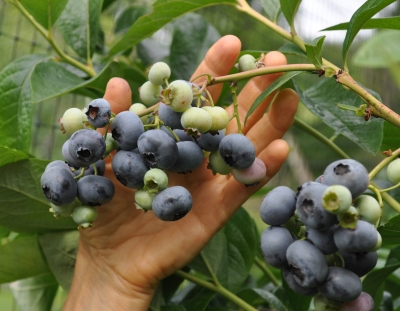
I’ve said it before but I’ll say it again. After many, many years of growing fruits in my not-particularly-good-for-fruit-growing site, blueberries — a native fruit — have always yielded well. Two most important things are adapting the soil to blueberries’ unique requirements, and keeping birds at bay. Birds at bay? Best is a walk-in, netted area.
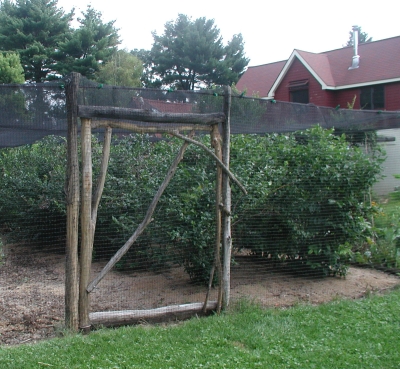
Soil for blueberries needs to be very acidic, with a pH between 4 and 5.5, made so, if needed, with the addition of sulfur, a naturally mined mineral. The pelletized form is best because it’s not dusty. Blueberry roots need good drainage and consistent moisture. They thrive in ground rich in organic matter, maintained with an annual three-inch topping of some weed-free, organic material such as wood shavings, wood chips, straw, pine needles, and autumn leaves.
(That’s the bare bones for success with blueberries. For a deeper dive into growing this healthful, delicious, reliable fruit, stay tuned for my soon-to-be-aired blueberry webinar.)
And More Berry-Like Fruits Coming Along
Just as last year’s apples were losing their crispness and tang and I needed a change from oranges, other berries, in addition to blueberries have started changing color, softening, and turning flavorful.
Black currants are another one of my favorites now ripening. They admittedly have an intense flavor not to everyone’s liking. But everyone likes black currants conjured up into juices, pastries, or jam. Variety matters. My favorites are Belaruskaja, Minaj Smyrev, and Titania.
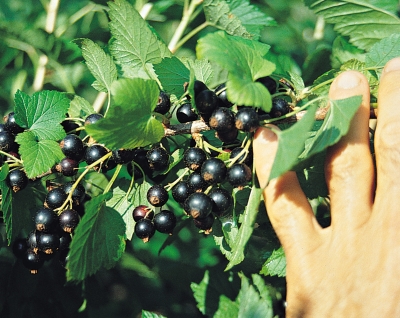
Don’t think black currants taste anything like “dried” or “Zante” currants. Those are raisins, originally made from “Black Corinth” grapes, a name then bastardized to “black currant.”
Like blueberries, black currants are easy to grow. But they have no special soil requirements, they fruit well even in some shade, and deer rarely eat the bushes, and birds rarely eat the berries.
Another tasty morsel now ripe is gumi (Elaeagnus multiflora). Birds usually strip this shrub clean of fruit, except this year the crop is so abundant that neither I nor the birds can make much of a dent in it. The berries are a little astringent if not dead ripe. And not at all if the fruit is processed; last year I cooked them slightly, strained out the seeds (which are edible), and blended it before drying it into a “leather.”

The gumi shrub itself has silver leaves, providing an attractive backdrop for the red fruits. The flowers are extremely fragrant, and the roots enrich the soil by taking nitrogen from the air (with the help of an actinomycete microorganism.)
Also now abundant, with plenty for all, is Nanking cherry (Prunus tomentosa), a favorite of mine for beauty and easy-to-grow cherries. The cherries are small, usually no larger than about 3/8 inch. But the single pit is also small. Flavor lies somewhere on the spectrum between sweet and sour cherries, very refreshing especially when chilled.

Nanking cherry fruit and bloom
Another Chance, and Then Another
All is not rosy in the berry-size fruit world. Over the years, I had heard about and tried a new fruit in town, edible honeysuckles. In the past, the plants I tried either died over winter or bore very few, very mediocre berries. Since then, edible honeysuckles have come up in the world, with serious breeding work, and I was given the opportunity to try them again. (As Maria Schinz said, “Gardening is an exercise in optimism.”)
But first, what is an edible honeysuckle, which now goes under better names. If called “honeyberry,” it usually refers to Russian species such as Lonicera caerulea app. kamtshatica or edulis. Haskap is a Japanese name applied the Japanese species L. caerulea spp. emphylocalyx, or to hybrids of this species with Russian species. Pure Japanese species varieties are sometimes called Yezberry, after the Island of Hokkaido, called Yez or Yezo Island where they are found. The Japanese species and hybrids are less susceptible to spring frosts than the honeyberries.
This spring I planted out two Yezberry varieties, Solo and Sugar Mountain Blue. The small, blue berries ripen early, and I was eager to give this fruit another try. Solo is bearing. The taste? Awful! Sour, with no other flavor.
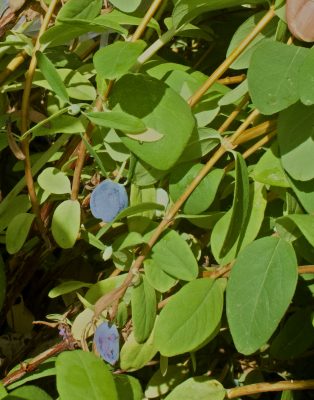
Solo yezberry
But I’m not abandoning edible honeysuckles. I’ve learned that the berries need to hang on the branches for a long time before developing full flavor and sweetness. A number of varieties are available, some of which are, according to others, “Delicious when eaten fresh from the plant” and “a bit like a cross between a raspberry and a blueberry. . . sweetness of a raspberry with a hint of pleasant tartness.” Really?!
Many blue berries are still hanging on my Solo bush. I’ll leave them to hang longer there and perhaps morph from “awful” to “delicious,” and will report back. I have hope for this new fruit, not yet high hopes.
At the very least, honeyberries or haskaps might be able to tide me over from the end of frozen blueberries to the first of fresh blueberries.
BAD SEEDS? NO SEEDS?
/14 Comments/in Gardening, Planning, Vegetables/by Lee ReichEdamame Scare
Got a couple of scares in the garden this season. No, not some woodchuck making its way past the dogs and then through some openings in the fences to chomp down a row of peas (which look especially vibrant this year, thank you). And no late frost that wiped out my carefully tended tomato transplants.
The first scare came last week as I looked down on the bed where I had planted edamame a couple of weeks previously. No green showed in the bed, a stark contrast to the nearby bed planted at the same time with snap beans, the small plants enjoying the warm sunshine and neatly lined up four inches apart in two rows down the bed.
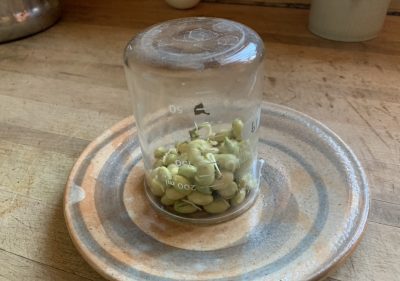
Testing edamame seeds
Scratching gingerly into the soil of the edamame bed did not reveal any seeds germinating but not yet above ground. In fact, I couldn’t find any seeds at all! Had I opened furrows and forgotten to plant seeds in them before covering the furrow? Doubtful, especially since I had planted another bed, still barren, in the other vegetable garden at the same time. Had a mouse or some other animal cruised underground enjoying a snack every four inches down the row? That would be a very thorough rodent. Plus, he or she would have left a tunnel.
Had the seeds rotted? Possibly, but that would be very quick for them to so thoroughly disappear. Had the seeds been old, which would make them more prone to rotting? I do save my own edamame seed every year, the variety Shirofumi, so that is a possibility. Except that I planted last year’s seed.
The mystery still exists but there was still time for action. I had additional Shirofumi seed left. Rather than just plant it, I’d test its germination, which I did by sprouting the seeds indoors. After an overnight soak in a beaker, I poured off the water and then rinsed the seeds twice daily. As it turned out seed from 2018 and 2015 didn’t germinate at all.
Last year’s seed germinated very well, and I planted them while their root sprouts were still very short. One week later, the plants have emerged. But the mystery still exists.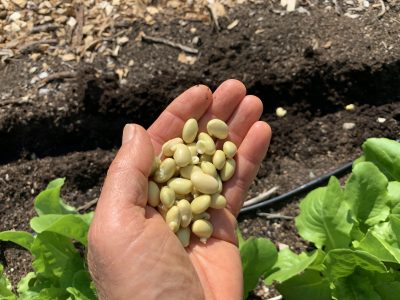
What If?
The second scare of the season is seed-related but hypothetical. What if seeds are unavailable next year, or any year? Or, at least, seeds of some of the varieties I want to grow.
This fear is not all that hypothetical. This spring, because of the surge in interest in gardening, seeds were harder to get.
And in years past, seeds of some of my favorite varieties of vegetables became difficult to find. Sweet Italia pepper, for instance, which I consider the best as far as flavor and early ripening for colder climates. My recourse has been to save my own seeds of these varieties for many years. In addition to Sweet Italia, I also save seed of Pink Pearl and Pennsylvania Dutch Butter popcorn, Otto File polenta corn, and, as mentioned above, Shirofumi edemame.

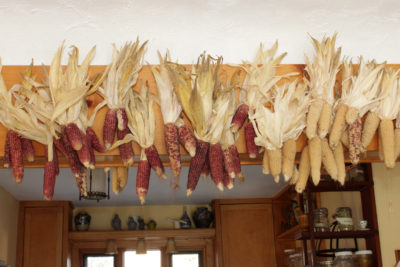
This season, the plan is to save seed of more vegetables.
A few guidelines will make seed-saving a success. First, I won’t save seed from “F-1 hybrids;” they are produced with selected, different parents, so the saved seed will not yield the same variety as the seed that is saved.
Selecting seeds from too few individuals can result in inbreeding depression, or generally weaker plants. So my second guideline is to save a few seeds from a lot of plants, then combine them to put more genetic diversity into the seed packet packet. Saving seed from more than one plant also provides insurance just in case a seed plant dies.
Some vegetable plants — corn, onions, and the cabbage family, for example — are especially prone to inbreeding depression. Saving seeds from Otto File and my popcorns is especially easy since the seeds are dry and mature when ready to eat or save. When I twist the kernels off an ear for eating, I just take out a few to add to my growing seed packet of that particular variety.

Arugula (Cabbage family) flower and seedpod
A third consideration in saving seed is keeping the seed true to variety. Varieties of sweet corn readily cross-pollinate. Again, it is corn, onions, and the cabbage family that are among the common vegetables that readily cross pollinate. So I grow popcorn in one vegetable garden and sweet corn in the other, and Otto File corn out in my meadow between dwarf apple trees. If my Golden Bantam sweet corn were to grow too close to my Pink Pearl Popcorn, the resulting seeds will grow into plants yielding kernels that were less sweet or less poppable.
Although squashes have separate female and male flowers on the same plant, which would make them prone to cross-pollination, that’s no problem here.  I grow only Sweet Mama and Waltham winter squashes. The first variety is botanically Cucumbita maxima and the second is C. moschata; the two species do not cross-pollinate.
I grow only Sweet Mama and Waltham winter squashes. The first variety is botanically Cucumbita maxima and the second is C. moschata; the two species do not cross-pollinate.
Plants that can self-pollinate, such as tomatoes, peppers, beans, and peas, could be contaminated by pollen from other, nearby varieties.  Distance between varieties can prevent cross-pollination. So can fine mesh bags. I plan to use small organza bags normally sold for wedding favors.
Distance between varieties can prevent cross-pollination. So can fine mesh bags. I plan to use small organza bags normally sold for wedding favors.
And finally, good storage, meaning dry and cool or cold conditions, makes sure seeds germinate well. Which my edamame did not. Hmmm.
(For more depth in seed saving, see the excellent and thorough book Seed to Seed: Seed Saving and Growing Techniques for Vegetable Gardeners by Suzanne Ashworth.)
ALL FOR THE FUTURE
/16 Comments/in Gardening, Planning, Vegetables/by Lee ReichSeeding Transplants? Again.
Only a couple of weeks ago I finished planting out tomato, pepper, melon, and the last of other spring transplants, and here I am today, sowing seeds again for more transplants. No, that first batch of transplants weren’t snuffed out from the last, late frost when the thermometer dropped to 28°F on May 13th.
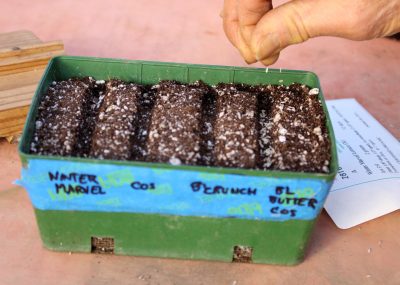
And no, those transplants were not clipped off at ground level, toppled and left lying on the ground, by cutworms. Neither were they chomped from the top down to ground level by rabbits.
I’m planting seed flats today to keep the harvest rolling along right through late autumn.
Future Further
Looking farthest ahead, I have in hand two packets of cabbage seed, Early Jersey Wakefield and Bartolo. Early Jersey Wakefield is a hundred year old variety with very good flavor and pointy heads, due to mature a couple of months after transplanting. Once those heads firm up, they can keep well out in the garden for a few weeks in the cool, autumn weather. Those I set out in spring, once mature, are apt burst open from rapid growth in summer weather. Bartolo yields firm, round heads that store in good condition after harvest, well into winter. They are ready for harvest 115 days after transplanting.
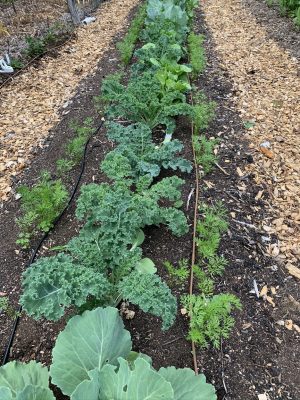
I plan for any of today’s sowings to spend about a month in their containers before being planted out. Cooler weather and lowering sunlight dramatically slow plant growth around here by early October, so any late ripening vegetables need to be ready or just about ready for harvest by then. Bartolo cabbage, with 30 days in a seed flat plus 115 days out in the garden, is then ripe by . . . whoops . . . the END of October! No wonder Bartolo often didn’t ripen for me in the past. (Nothing like writing about my garden to keep me honest and awake. I should re-read the detailed timing schedule I wrote in Weedless Gardening for various vegetables in various climates.)
Okay, all is not lost for winter storage cabbage. Warm weather, timely water from drip irrigation, and soil enriched with plenty of compost might speed maturity along faster than predicted. Unseasonally warm weather through October would also help ripen nearly ripe heads. And there’s always the fallback, with sure-to-ripen Early Jersey Wakefield.
Still on time, guaranteed, will be today’s sowing of Charming Snow cauliflower, maturing 60 days from transplanting.
That’s it, for now, for the cabbage family. Later on in summer I’ll be sowing Chinese cabbage seeds. Perhaps more kale also, although spring sowings of this almost perfect vegetable can carry on right into winter, even spring if the winter is sufficiently mild.
Future Sooner
For sooner use in the coming weeks will be today’s sowings of lettuce, cucumber, and summer squash. I like lettuce but lettuce doesn’t like hot weather and longs days. Those conditions cause leaves to turn bitter as plants send up flower stalks and go to seed. But if I sow a pinch of seeds in flats every couple of weeks, the transplanted lettuce can usually be harvested small, before it’s socked away enough energy and wherewithal to go to seed.
The cucumber transplants I’ll want on hand to replace cucumber plants that I set out a couple of weeks ago. After a few weeks those spring plantings invariably succumb to powdery mildew and cucumber beetles, which not only feed on the plants but also spread bacterial wilt disease. (Easy identification for bacterial wilt, besides a wilting plant, is the thread of bacterial ooze visible as you pull apart a cut stem.)
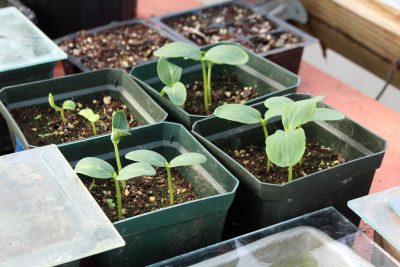
Summer squash plants also peter out during summer, mostly from, again, powdery mildew, and also from squash bugs and vine borers. If squash vines are covered with soil along their stems, roots will form at the nodes, and the plant will continue production. I’ve got to be careful in saving the older squash plants, though; it’s too easy to have too much of this vegetable.
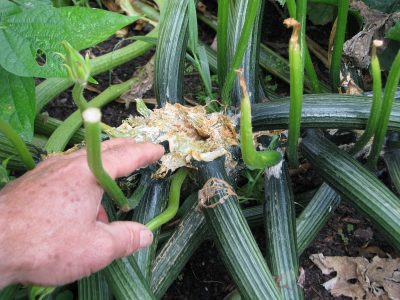
Memorial Day, Before, During, and After It
Here in the States, the traditional time to plant a vegetable garden, is for some reason, Memorial Day weekend. But that can’t be true from Oregon to Florida and from Maine to Arizona, with our wide variations in climate!
I did put tomatoes, peppers, and plenty of transplants in the ground here during Memorial Day weekend. But I already had sown seeds or transplants of peas, arugula, lettuce, kale, carrots, celeriac before that weekend. And, as I’ve written above, there’s plenty of planting to be done after that date. Memorial Day weekend is not a seminal date in my gardening calendar.

